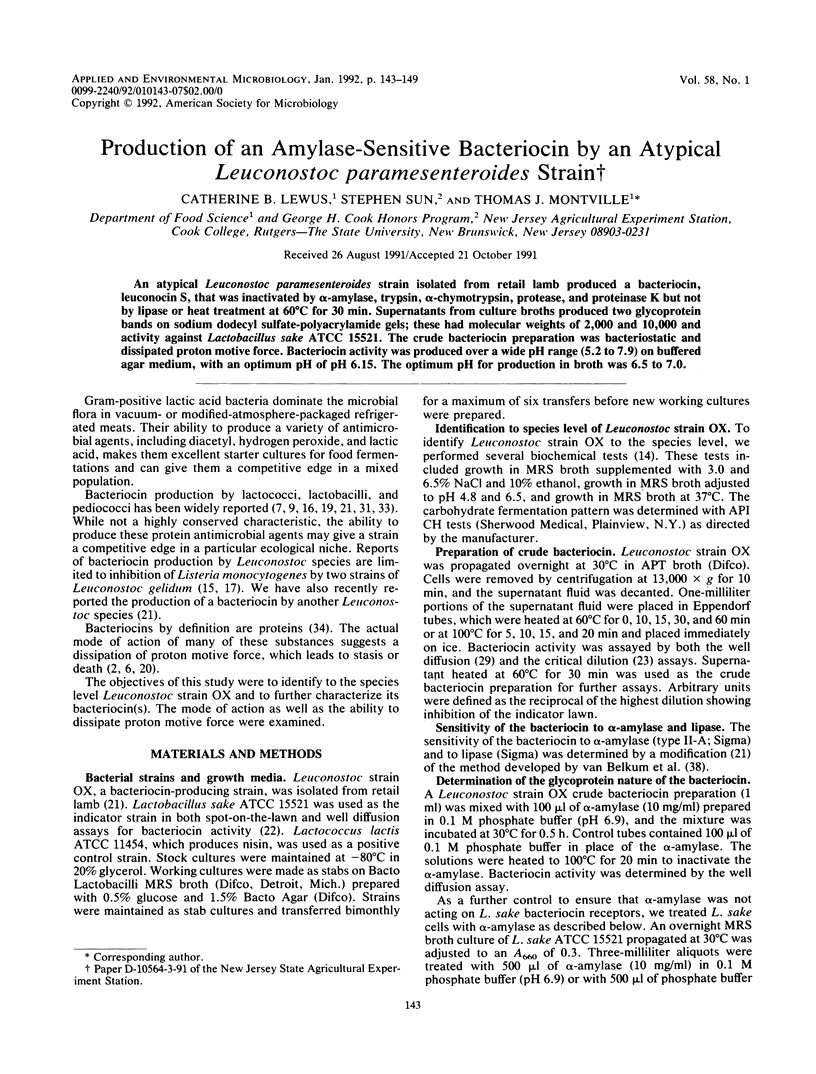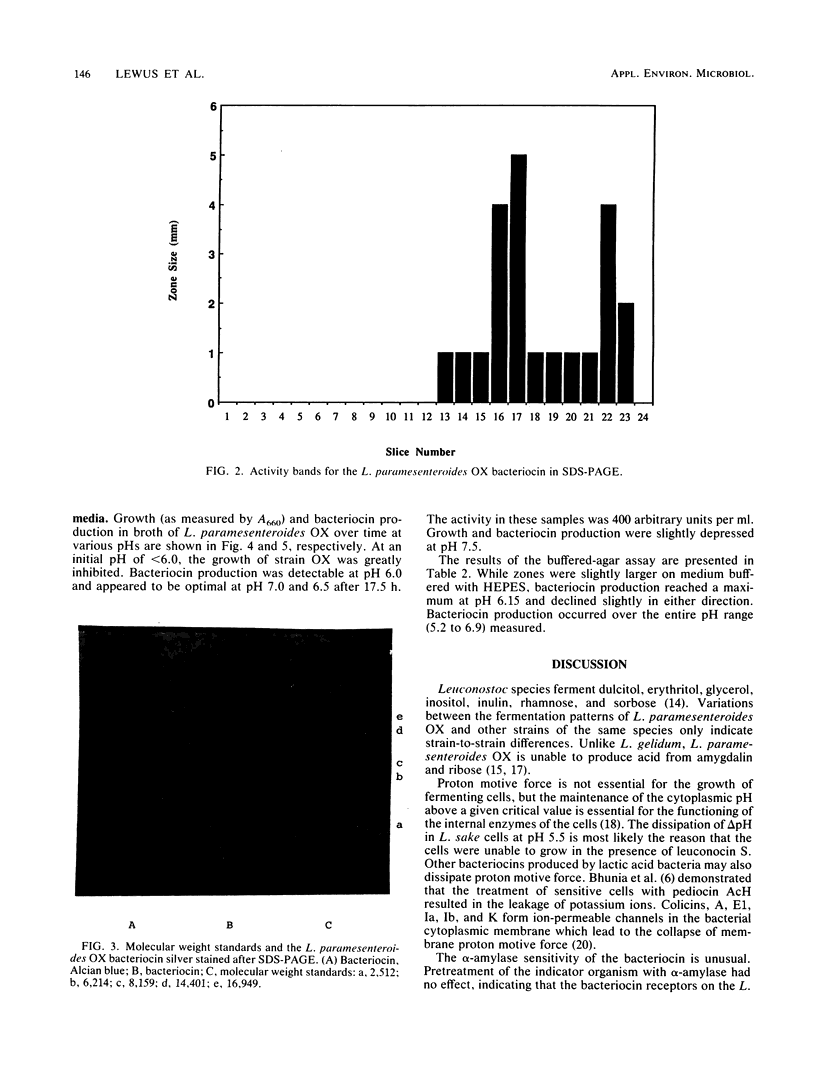Abstract
An atypical Leuconostoc paramesenteroides strain isolated from retail lamb produced a bacteriocin, leuconocin S, that was inactivated by α-amylase, trypsin, α-chymotrypsin, protease, and proteinase K but not by lipase or heat treatment at 60°C for 30 min. Supernatants from culture broths produced two glycoprotein bands on sodium dodecyl sulfate-polyacrylamide gels; these had molecular weights of 2,000 and 10,000 and activity against Lactobacillus sake ATCC 15521. The crude bacteriocin preparation was bacteriostatic and dissipated proton motive force. Bacteriocin activity was produced over a wide pH range (5.2 to 7.9) on buffered agar medium, with an optimum pH of pH 6.15. The optimum pH for production in broth was 6.5 to 7.0.
Full text
PDF






Images in this article
Selected References
These references are in PubMed. This may not be the complete list of references from this article.
- Ahmed S., Booth I. R. The use of valinomycin, nigericin and trichlorocarbanilide in control of the protonmotive force in Escherichia coli cells. Biochem J. 1983 Apr 15;212(1):105–112. doi: 10.1042/bj2120105. [DOI] [PMC free article] [PubMed] [Google Scholar]
- Andersson R. E., Daeschel M. A., Hassan H. M. Antibacterial activity of plantaricin SIK-83, a bacteriocin produced by Lactobacillus plantarum. Biochimie. 1988 Mar;70(3):381–390. doi: 10.1016/0300-9084(88)90211-8. [DOI] [PubMed] [Google Scholar]
- Barefoot S. F., Klaenhammer T. R. Purification and characterization of the Lactobacillus acidophilus bacteriocin lactacin B. Antimicrob Agents Chemother. 1984 Sep;26(3):328–334. doi: 10.1128/aac.26.3.328. [DOI] [PMC free article] [PubMed] [Google Scholar]
- Bhunia A. K., Johnson M. C., Ray B. Purification, characterization and antimicrobial spectrum of a bacteriocin produced by Pediococcus acidilactici. J Appl Bacteriol. 1988 Oct;65(4):261–268. doi: 10.1111/j.1365-2672.1988.tb01893.x. [DOI] [PubMed] [Google Scholar]
- Chung K. T., Dickson J. S., Crouse J. D. Effects of nisin on growth of bacteria attached to meat. Appl Environ Microbiol. 1989 Jun;55(6):1329–1333. doi: 10.1128/aem.55.6.1329-1333.1989. [DOI] [PMC free article] [PubMed] [Google Scholar]
- Fikes J. D., Crabtree B. L., Barridge B. D. Studies on the mode of action of a bacteriocin produced by Bacillus stearothermophilus. Can J Microbiol. 1983 Nov;29(11):1576–1582. doi: 10.1139/m83-240. [DOI] [PubMed] [Google Scholar]
- Gagliano V. J., Hinsdill R. D. Characterization of a Staphylococcus aureus bacteriocin. J Bacteriol. 1970 Oct;104(1):117–125. doi: 10.1128/jb.104.1.117-125.1970. [DOI] [PMC free article] [PubMed] [Google Scholar]
- Harding C. D., Shaw B. G. Antimicrobial activity of Leuconostoc gelidum against closely related species and Listeria monocytogenes. J Appl Bacteriol. 1990 Nov;69(5):648–654. doi: 10.1111/j.1365-2672.1990.tb01558.x. [DOI] [PubMed] [Google Scholar]
- Hastings J. W., Stiles M. E. Antibiosis of Leuconostoc gelidum isolated from meat. J Appl Bacteriol. 1991 Feb;70(2):127–134. doi: 10.1111/j.1365-2672.1991.tb04438.x. [DOI] [PubMed] [Google Scholar]
- Klaenhammer T. R. Bacteriocins of lactic acid bacteria. Biochimie. 1988 Mar;70(3):337–349. doi: 10.1016/0300-9084(88)90206-4. [DOI] [PubMed] [Google Scholar]
- Konisky J. Colicins and other bacteriocins with established modes of action. Annu Rev Microbiol. 1982;36:125–144. doi: 10.1146/annurev.mi.36.100182.001013. [DOI] [PubMed] [Google Scholar]
- Lewus C. B., Kaiser A., Montville T. J. Inhibition of food-borne bacterial pathogens by bacteriocins from lactic acid bacteria isolated from meat. Appl Environ Microbiol. 1991 Jun;57(6):1683–1688. doi: 10.1128/aem.57.6.1683-1688.1991. [DOI] [PMC free article] [PubMed] [Google Scholar]
- Nielsen J. W., Dickson J. S., Crouse J. D. Use of a bacteriocin produced by Pediococcus acidilactici to inhibit Listeria monocytogenes associated with fresh meat. Appl Environ Microbiol. 1990 Jul;56(7):2142–2145. doi: 10.1128/aem.56.7.2142-2145.1990. [DOI] [PMC free article] [PubMed] [Google Scholar]
- Pátek M., Hochmannová J., Nesvera J., Stránský J. Glutamicin CBII, a bacteriocin-like substance produced by Corynebacterium glutamicum. Antonie Van Leeuwenhoek. 1986;52(2):129–140. doi: 10.1007/BF00429316. [DOI] [PubMed] [Google Scholar]
- Schillinger U., Lücke F. K. Antibacterial activity of Lactobacillus sake isolated from meat. Appl Environ Microbiol. 1989 Aug;55(8):1901–1906. doi: 10.1128/aem.55.8.1901-1906.1989. [DOI] [PMC free article] [PubMed] [Google Scholar]
- Tagg J. R., Dajani A. S., Wannamaker L. W. Bacteriocins of gram-positive bacteria. Bacteriol Rev. 1976 Sep;40(3):722–756. doi: 10.1128/br.40.3.722-756.1976. [DOI] [PMC free article] [PubMed] [Google Scholar]
- Tseng C. P., Tsau J. L., Montville T. J. Bioenergetic consequences of catabolic shifts by Lactobacillus plantarum in response to shifts in environmental oxygen and pH in chemostat cultures. J Bacteriol. 1991 Jul;173(14):4411–4416. doi: 10.1128/jb.173.14.4411-4416.1991. [DOI] [PMC free article] [PubMed] [Google Scholar]
- Upreti G. C., Hinsdill R. D. Isolation and characterization of a bacteriocin from a homofermentative Lactobacillus. Antimicrob Agents Chemother. 1973 Oct;4(4):487–494. doi: 10.1128/aac.4.4.487. [DOI] [PMC free article] [PubMed] [Google Scholar]
- van Belkum M. J., Hayema B. J., Geis A., Kok J., Venema G. Cloning of two bacteriocin genes from a lactococcal bacteriocin plasmid. Appl Environ Microbiol. 1989 May;55(5):1187–1191. doi: 10.1128/aem.55.5.1187-1191.1989. [DOI] [PMC free article] [PubMed] [Google Scholar]



